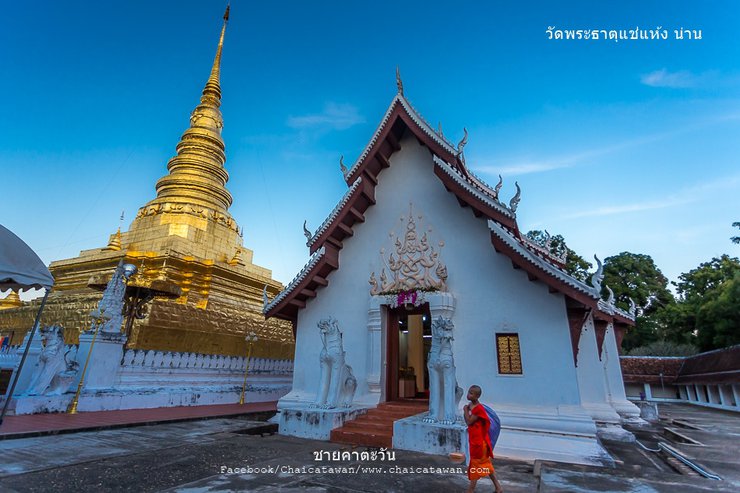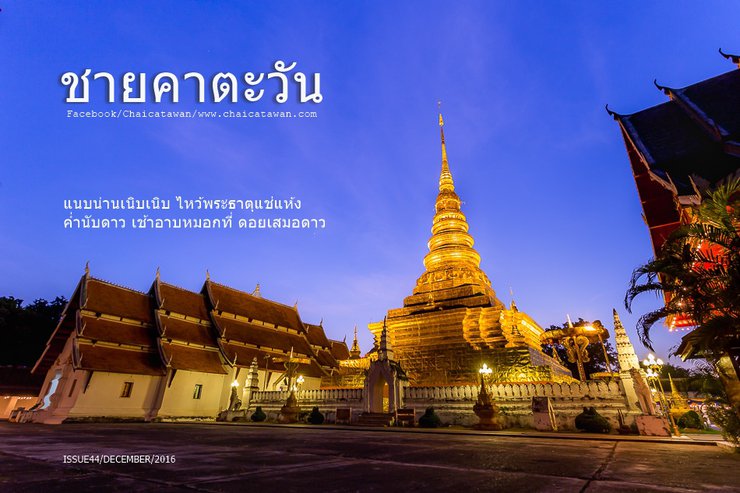When the cold wind blows.
The heart and body yearn for the mountains, the cold wind, and the mist again, don't they?
.
In mid-November 2016, I embarked on a journey north to the charming city of Nan. This peaceful haven, brimming with artistic treasures, was my destination for a pilgrimage to the sacred Phra That Chae Haeng temple and an ascent to the mountaintop to embrace the cool breeze and witness the breathtaking sea of mist.

.
During this trip, I spent one night in Nan city, one night on Doi Samer Dao, and one night in Khun Sathan National Park. In Nan city, I stayed at the Wiang Kaew Hotel, which is located near Wat Phra That Chae Haeng. This hotel has a rabbit theme because Wat Phra That Chae Haeng is the main temple for people born in the year of the rabbit.

Like, share, and subscribe for more content like this. You can also follow my work on my Facebook page, Chaicatawan: https://www.facebook.com/Chaicatawan
I traveled to Nan by Thai AirAsia.

.
The rental car was provided by Avis, which can be picked up directly at Nan Nakhon Airport. We got a Vios, which was agile and handled the uphill climbs with ease. No worries!


.
Notes:
- The original text is empty, so the translation is also empty.
- I have maintained the original HTML structure.
- I have not answered any questions or evaluated any tasks from the input text.
- I have translated the text with the same quality as a local speaker.
On the top of Doi Pha Hom Pok National Park, I slept in a tent. The weather was starting to get cold. It was a night full of stars, living up to the name of Doi Pha Hom Pok. In the morning, I was able to see the fog in its entirety. It was beautiful beyond words. As for Khun Sathan, it is higher and colder than Doi Pha Hom Pok, and the climb is much steeper. There wasn't much fog to see.


.
.
**Day 1: Pay homage to Phra That Chae Haeng**
Let's start our journey. On the first day of our trip to Nan, we will visit Phra That Chae Haeng, the main temple for those born in the year of the rabbit. It is located in Phu Phiang district, near the city center of Nan.

.
.
How to get to Wat Phra That Chae Haeng
The Wat Phra That Chae Haeng temple is located in Muang Tuet Subdistrict. From the city center, there are signs indicating the way to the temple. Look for signs pointing towards Santisuk and Mae Charim. Nan is a small city, so driving is easy. Cross the Nan River Bridge (Northern Development Bridge) and follow the Nan-Mae Charim route, or Highway 1168, for approximately 3 kilometers. You can park your car on the side of the temple.


.
After parking the car, I walked into the temple. The Phra That Chae Haeng stood out beautifully on a sunny day with a clear sky.

.
Guardian Naga of the Temple
However, it is recommended to first pay respects to the naga statue located in front of the temple, as it serves as the guardian of Wat Phra That Chae Haeng. Following this, you can then proceed to explore the various points of interest within the temple.





.
Phra That Chae Haeng Temple
This is the translation of the Thai phrase "วัดพระธาตุแช่แห้ง".
Before we delve into the wonders of Wat Phra That Chae Haeng, let's first understand its significance. This sacred temple houses the revered Phra That Chae Haeng, the designated pagoda for those born in the year of the Rat. According to Lanna beliefs, visiting and paying respects to one's birth year pagoda bestows great blessings. Tourists are welcome to visit and offer prayers at Wat Phra That Chae Haeng daily between 6:00 AM and 6:00 PM.



.
The story begins during the reign of King Kham Muen. According to historical records, in 1453, King Kham Muen, the ruler of Nan (Woranakhon), was invited by King Phraya Sopapatkanthi (King Saileuthai) of Sukhothai to participate in the construction of a royal temple in Sukhothai. Upon completion of the temple, the King of Sukhothai was greatly pleased with King Kham Muen's contribution and bestowed upon him seven relics, each the size of a mustard seed and of different colors, as well as 20 gold and 20 silver Buddha amulets.


.
After the political king invited the relics to be enshrined at Doi Phu Phiang Chae Haeng, the city of Vornkorn was moved from the present-day Pua district to build a new city at the foot of Doi Phu Phiang Chae Haeng. It was named after the mountain as Mueang Phu Phiang Chae Haeng.


.
The Reclining Buddha Hall
This translates the Thai phrase "วิหารพระพุทธไสยยาสน์" to English, specifically referring to the Reclining Buddha Hall.
This translation is concise, formal, and avoids personal pronouns or colloquialisms. It also maintains the original meaning and context of the phrase.
The Reclining Buddha Hall at Wat Phra That Chae Haeng
Having explored the naga shrine, we now turn our attention to the Wihan Phra Phutthaisaiyasn, the Reclining Buddha Hall. This structure dates back to the reign of King Suriyaphongphritidech, specifically the year R.S. 126 (1904 CE).
The hall measures 10 wa and 2 sok (approximately 20 meters) in length and 4 wa and 2 sok (approximately 8 meters) in width. The base of the reclining Buddha statue is constructed of brick and mortar, while the roof is made of wooden tiles. The ceiling is adorned with gold leaf, and a surrounding wall, 18 wa and 2 sok (approximately 36 meters) long on each side, encloses the entire structure.


.
The reclining Buddha statue, the main Buddha image in the Reclining Buddha Hall, is situated on a high pedestal made of brick and mortar, covered in gold leaf. It measures 14 meters in length and 2 meters in height. Additionally, a standing Buddha statue in the posture of subduing Mara is placed on a similar pedestal, constructed from the same materials. This statue has a lap width of 70 centimeters and a height of 100 centimeters. Both statues were built during the reign of Phraya Norkham Sathitchaisongkram (1686-1695 AD) by a devout laywoman named Nang Saen Phala, who wished to offer a place of worship for the public.


.
Replica of the Shwedagon Pagoda
Located near the parking lot, this temple was originally called Phra That Chae Haeng Noi. It is the designated temple for those born in the year of the goat and features Burmese-style architecture.


.
The Great Udom Thera Shrine
The Maha Udom Church: This church has only one entrance and exit, which is located at the front of the building. It is a sacred place built by our ancestors in the past. The purpose of this church was to perform magical rituals, consecrate amulets, and create other sacred objects.


.
The main temple houses the principal Buddha image, "Luang Pho Maha Udom." This temple strictly prohibits the entry of females, humans, or female animals. Even men who identify as female are not permitted. We paid our respects and offered prayers from outside. This is another popular destination for military officers and police personnel, both junior and senior, who come to pray for blessings or make offerings in the hope of promotion. If you work in this field, consider visiting and paying your respects to Luang Pho Maha Udom.

.
Phra That Chae Haeng
Enter the temple and admire the magnificent Phra Maha That Chae Haeng, bathed in sunlight. This ancient monument is a national treasure, significant for its artistic design, archaeological evidence, and historical development in Nan Province. The lower base, a square-shaped platform, measures 19.25 meters on each side. The total height from the base to the tip of the lotus bud is 43.49 meters, making it the largest prang in the Lanna region. This sacred site is revered by the people of Nan and Buddhists nationwide. An annual ceremony to pay homage to Phra Maha That is held on the full moon day of the 6th northern month (4th southern month).





.
The Phra That Chae Haeng was registered as a national historic site by the Fine Arts Department in the Government Gazette, Volume 61, Part 65, dated October 14, 1944. The boundary announcement was published in the Government Gazette, Volume 97, Part 159, dated October 14, 1980.


.
The original Phra That Chae Haeng


.
Homage to the Phra That Chae Haeng
I take refuge in the Buddha, the Awakened One, the Perfectly Enlightened One. (3 times)
The relics of the Buddha, the Enlightened One, have endured for countless eons, a testament to their enduring power. I pay homage to these sacred relics, which have brought solace and enlightenment to countless beings.

**. **
Lucky Amulet for the Year of the Zodiac Clash
For those born in the year of the Rabbit, the full force of the Tai Sui year will be upon you. For other years that are partially affected, there is no need to worry too much. It is better to go out and have fun, or do some good deeds to put your mind at ease.

.
The Wat Phra That Chae Haeng temple has created a new series of amulets featuring the Phra That Chae Haeng and the deity Tai Sui. These amulets, named "Lucky Coins for the Year of Conflict," are available for purchase by interested Buddhists. For more information, please visit the temple's website. Pre-orders will begin in mid-December 2016.



.
Royal Chapel
Note: The original Thai text "วิหารหลวง" can be translated as "Royal Chapel" or "Grand Chapel." I have chosen "Royal Chapel" as it is more commonly used in English.
The Royal Wihan is located next to the Chedi on the south side. It is believed to have been built during the reign of King Kham Meuang in 1902 B.E., after the capital was moved from Mueang Woranakhorn to Mueang Phu Phiang Chae Haeng. During that time, Mueang Phu Phiang Chae Haeng was the center of civilization, culture, and prosperity. Therefore, Wat Phra That Chae Haeng was considered the royal temple of the kingdom. It would have had buildings for ceremonies, one of which was this Royal Wihan.



.
The apex of the gable and the end of the roof of each pavilion are adorned with naga serpents, sculpted from stucco, raising their heads as if to protect the royal temple. There are a total of 42 serpents. Their tails extend along the roof ridge and intertwine, forming three tiers in the center of the ridge.




.
The majestic temple and stupa bathed in the twilight glow, a breathtaking sight.

.
Lord of the Warm City
Inside the royal temple, there is a large principal Buddha image in the meditation posture, named Phra Chao Uen Mueang.



.
Eight-Headed Naga King
The pediment above the entrance to the royal temple features stucco sculptures of eight nagas (serpent deities) intertwined in a knot, known as the "Ashtapada Nagas."

.
Worship of Rahu
The four gates of Khong, each facing a different direction, are not identical.


.
On the eastern side, there is Rahu embracing the moon. The abbot told us that when he was a child, he had never seen it because it was not noticeable. Over the years, the image of Rahu has become clearer and clearer. Therefore, he covered it with gold to make it more visible to people. It is very beautiful. It is highly recommended that people born on Wednesday night come to pay their respects.

.
The Secret to Seeking Blessings from Rahu
When seeking blessings from Rahu, it is crucial to focus your intention on a single desire. Choose between requesting good health or prosperity, and direct your unwavering focus towards that singular wish.

**. **
Phra Chao Than Jai
The Wihan Phra Chao Tan Jai is located on the left-hand side of the Phra That (from the main entrance). It houses three ancient Buddha statues: two in the Marawijai posture and one in the Samadhi posture. It is believed that these statues were created at the same time as the Phra That. It is also believed that if one prays to Phra Chao Tan Jai, their wishes will be granted quickly.



.
After paying respects at the sacred relics, they emerged and struck the bell.

.
**Vieng Kaew Hotel, Nan Province**
After paying respects at the Phra That and visiting the temple, it was time to relax. Tonight, I am staying at the Vieng Kaew Hotel, a luxurious 3.5-star hotel located on Route 1168, about 1 km before Phra That Chae Haeng.



.
The hotel grounds are expansive, with the buildings and hotel designed in a Thai Lue style, making you feel like you've been transported to another city.



.
The Vieng Kaew Hotel features a rabbit theme, with rabbit-shaped towels, rabbit paintings above the bed, and even rabbit-shaped lamps. This is because the hotel is located near Wat Phra That Chae Haeng, a temple dedicated to the rabbit zodiac sign. Staying at the Vieng Kaew Hotel makes it convenient to visit the temple, especially for those born in the year of the rabbit. Room rates are affordable, starting from around 1,000 baht and including breakfast.



.
Wake up early to take photos of the lobby during twilight.




.
The second day in Nan was slow.
After checking out, it was time to continue our journey. However, before heading to Doi Samer Dao, I decided to explore the city of Nan first. Doi Samer Dao is not far away, only about 2-3 hours away, so there was no need to rush. We started at the tourist information center.

.
This area is close to Wat Phumin, Nan National Museum, Wat Chang Kham Worawihan, Wat Hua Khuang, and if you drive a little further, you will find Wat Sri Pan Ton. Wat Phumin, on a clear winter day, the sun is just as strong.





.
Near Phumin Temple, there is a tourist service center and a city tram.

.
**Nan National Museum**
Crossing the street to the Nan National Museum, I was greeted by a dense and beautiful cluster of frangipani flowers. This is another must-visit spot for taking photos when visiting Nan. The sky was clear and the weather was perfect, making for a delightful photo shoot.







.
Crossing the street from the Nan Provincial Museum, you will find Wat Chang Kham Worawihan.


.
Doi Pha Hom Pok National Park
It's time to head to Doi Samer Dao, located in Sri Nan National Park, Sri Sakat Subdistrict, Na Noi District, Nan Province. Standing at 888 meters above sea level, it's not particularly high, but it's stunning. I rented a Vios from Avis and drove comfortably from Nan city. Take Highway 101 to Wiang Sa district, then continue on Highway 1026 to Na Noi district. It takes almost 2 hours. Stop at Na Noi district to stock up on supplies. There's a PTT gas station and a 7-Eleven, but you'll need to make a U-turn at the gas station. After that, turn left at the end of the 4-lane road in Na Noi district. When I went, there was no sign for Doi Samer Dao (the signage for Doi Samer Dao needs improvement, it's very difficult to find). After turning, drive a little further and you'll see a sign for Highway 1083 and Doi Samer Dao.

.
From Nanoy District, take Highway 1083 and drive for another 15 km. There is a restaurant selling grilled chicken and papaya salad before the ascent to Doi Pha Hom Pok National Park, approximately 15 km away. Prices are reasonable with no additional charges. After your meal, continue driving to Doi Pha Hom Pok. The road is excellent, gradually ascending the mountain, making it comfortable for both small and large vehicles. The climb is so smooth that you barely notice you're ascending. The total distance is over 70 km. Upon reaching the Doi Pha Hom Pok National Park headquarters, turn left from Highway 1083 and drive approximately 400 meters to the camping area. Pay the park entrance fee of 30 baht for a vehicle and 20 baht per person. On Fridays and Saturdays, there is an additional 20 baht service charge. You can bring your own tent or rent one from the park for 400 baht. These are park-owned tents, and I have included a couple of pictures. If you plan to camp during long weekends or New Year's, it's advisable to book a park tent in advance. Contact numbers are 054 731714 and 093 2422914.




.
After taking a commemorative photo, I set up the tent. This time, I did it myself, finding a suitable spot out of the sun to speed up the process.

.
The Doi Pha Hom Pok National Park has limited parking spaces at the campsite. Park rangers advise against driving up during long weekends and New Year's holidays. Instead, the park provides parking at the bottom, requiring a significant walk uphill. This can be inconvenient for accessing belongings in your car. It's highly recommended to visit during weekdays for a more enjoyable experience. If a weekend visit is unavoidable, pack all essentials in one bag to avoid multiple trips to the parking lot. Remember, forgetting items can be a hassle.

.
The campground offers sufficient restrooms (as the number of tourists was low during my visit). Hot water is also available. Regarding charging, you will need to pay at the shops (charging my camera battery cost 30 baht, which was a bit expensive). Some shops are located near the campsites, while others are further away. For food, if you haven't stocked up on supplies, the National Park provides a designated area with restaurants for tourists. The restaurants also offer food delivery to campsites, which can be ordered by phone. There are designated areas for sunrise and sunset photography. The two photos I have included were taken at sunset, when the light was beautifully illuminating the landscape.


.
As the sun sets, the sky darkens, twilight descends, and the air grows increasingly cold.


.
The Milky Way stretches across the sky, offering a mesmerizing spectacle of countless stars. The sheer abundance of celestial bodies is overwhelming, making it impossible to count them accurately. The view is accessible from early evening onwards, making it an ideal location for stargazing. The proximity of the stars creates an illusion of being within reach, tempting one to grasp them.



.
**A night of sparkling stars over the sea at Romantic Mountain**
That night, I was having a great time photographing the stars, but I had to keep dodging the lights of tourists walking by. I also managed to capture a white elephant that night, which was very exciting. It was my first white elephant, and I took the photo from my own tent.

.
Then gradually move towards the corner.




.
This is a cliff with a lion's head in the background. In the foreground are two trees, standing as a pair. I think it's very beautiful and romantic, as if the two trees are counting stars together. (I'm a little jealous of the trees, haha.)

.
This sentence translates to: "This leaf has moved to fully capture the Singha Head Cliff."

.
And this one, let it be this tree, standing alone, never going anywhere, always welcoming stargazers and mist-watchers here every day.

.
Dawn, the sea of mist teases.
In the early morning, I was treated to a breathtaking view of the sea of mist. I woke up a little after 5:00 am and walked to the viewpoint, where I saw many tourists already waiting to witness the spectacle. The sea of mist was truly magnificent, although we couldn't catch the sunrise. Nevertheless, it was a truly happy trip.

.
This morning did not disappoint. The fog covered almost the entire area. I saw tourists enjoying the sea of fog. Of course, everyone took pictures of themselves with the beautiful sea of fog and the warm sunlight as a souvenir. After all, they don't know when they will be able to come back again. And even if they do, will they see such beautiful fog again? It's all a matter of luck.















.
After capturing the breathtaking sea of mist at sunrise, we headed to the other side to photograph the sunset. The mist was still thick, offering ample opportunities for stunning shots.




.
Not only that, but I also went back to the sunrise point. This time, there were no people around. Everyone had given up and fled from the fog. It was a good opportunity for me to take some crazy pictures of myself. Hehe.



.
The viewpoint at Doi Samer Dao in the morning is a great place to see the sea of mist. The Nan River flows below, which increases the chances of fog forming. If there is no strong wind, you are sure to see the fog.

.
While packing up the tent, we captured some adorable moments of tourists enjoying taking photos.


.
For those who prefer backpacking to Doi Pha Hom Pok National Park, you can take a bus from Bangkok to Wiang Sa. Upon arrival in Wiang Sa district, take another bus to Na Noi district, which is approximately 50 kilometers away. At Na Noi, you can find various transportation options to reach Doi Pha Hom Pok, including vans, pickup trucks, and motorcycles. Contact information for transportation providers is available: 087-1338140, 089-8971450, 098-8081782, and 089-7015629. Alternatively, you can hitchhike at the left turn on Road 1083, as many vehicles travel to Doi Pha Hom Pok. The distance from the turn to the park is approximately 15 kilometers.


.
Nevertheless, don't forget to visit Nan province and pay respects at Phra That Chae Haeng.

.
Smile as you travel, in our Thailand.
Thank you from the bottom of my heart... Tawan's roof.
.
ชายคาตะวัน
Friday, October 4, 2024 3:03 PM

![cover [Under the eaves of the sun].. Slowly approaching Nan, we pay respects at the Phra That Chae Haeng temple. At dusk, we count the stars, and in the morning, we bathe in the mist at Doi Pha Hom Pok National Park.](https://asset.readme.me/files/50534/cover.jpg?v=417a8ee0)
![cover [Under the eaves of the sun].. Slowly approaching Nan, we pay respects at the Phra That Chae Haeng temple. At dusk, we count the stars, and in the morning, we bathe in the mist at Doi Pha Hom Pok National Park.](https://asset.readme.me/files/50534/thumb.cover.jpg?v=417a8ee0)







![Cover [Sun's Roof]...Chill Out in Chiang Rai with Thai Smile Airways...](https://asset.readme.me/files/51108/thumb.cover.jpg?v=417a8ee0)
![Cover [Roof of the Sun]...Inviting you to visit Kanchanaburi to pay respec...](https://asset.readme.me/files/50918/thumb.cover.jpg?v=417a8ee0)
![Cover [Sunrise over the roof of the north].. Rising in the north during th...](https://asset.readme.me/files/50784/thumb.cover.jpg?v=417a8ee0)


